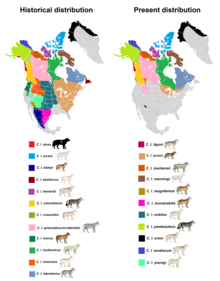基奈半島狼
| 基奈半島狼 化石時期:中更新世至1915年
| |
|---|---|

| |
| 科學分類 | |
| 界: | 動物界 Animalia |
| 門: | 脊索動物門 Chordata |
| 綱: | 哺乳綱 Mammalia |
| 目: | 食肉目 Carnivora |
| 科: | 犬科 Canidae |
| 屬: | 犬屬 Canis |
| 種: | 狼 C. lupus
|
| 亞種: | 基奈半島狼 C. l. alces
|
| 三名法 | |
| Canis lupus alces | |

| |
| 灰狼亞種在北美洲的分布 | |
基奈半島狼(學名:Canis lupus alces)是一個灰狼亞種。原分布在阿拉斯加州基奈半島,因人類捕殺而於1925年滅絕[3]。
體型[編輯]
基奈半島狼在被滅絕之前是北美最大的狼,身長為5-7英尺(150-215厘米),高35至44英寸(89-112厘米)。它的體長從60英寸到84英寸(5英尺到7英尺)不等,估計最重可達200-250磅[4][5][6]。
特徵[編輯]
愛德華·阿方索·戈德曼提出,基奈半島狼體型龐大可能是自然選擇的結果,因其主要依賴駝鹿為食[7][8]。
史密森尼學會收藏有基奈半島狼的一塊頭骨標本,編號為「USNM 147471」[9]。
歷史[編輯]
1941年,基奈半島狼被戈德曼劃分為阿拉斯加州四個灰狼亞種之一[1]。2005年出版的《世界哺乳動物》也將其認定為灰狼的一個亞種[10]。
20世紀前,牠們在基奈半島上很常見。然而,1895年,基奈半島開採出金礦,引發淘金熱。懼怕狂犬病的礦工隨即開始濫殺狼群。至1915年,狼群絕跡[11][12][13]。1925年,基奈半島狼被宣布滅絕[14]。
基奈半島狼絕跡五十年後,1960年代,基奈半島被發現有狼群重新定居[15]。儘管如此,基因組學研究表明,現有狼群與原基奈半島狼的遺傳相似性很小。因此,可以認為該亞種已經絕滅[16]。
參考文獻[編輯]
- ^ 1.0 1.1 Goldman, E. A. 1941 Sep 30. Proceedings of the Biological Society of Washington. 54: 109.
- ^ Canis lupus alces Goldman, 1941. ITIS.
- ^ Weckworth, Byron V.; Talbot, Sandra; Sage, George K.; Person, David K.; Cook, Joseph. A Signal for Independent Coastal and Continental histories among North American wolves (PDF). Molecular Ecology. 2005, 14 (4): 917–31 [2021-02-02]. PMID 15773925. doi:10.1111/j.1365-294X.2005.02461.x. (原始內容 (PDF)存檔於2010-06-19).
- ^ Fun Kenai Peninsula Wolf Facts For Kids. [2023-06-03]. (原始內容存檔於2023-06-03).
- ^ Kenai Peninsula Wolf. lookseek. [2021-02-04]. (原始內容存檔於2023-06-03).
- ^ Kenai Peninsula Wolf. FactRepublic. [2023-06-03]. (原始內容存檔於2022-08-19).
- ^ Goldman EA. 1944. Classification of wolves: part II. Pages 389– 636 in Young SP, Goldman EA, editors. The wolves of North America. Washington, D.C.: The American Wildlife Institute.
- ^ L. David Mech, The Wolf: The Ecology and Behavior of an Endangered Species, The Natural History Press, 1970, Appendix A page 2
- ^ Smithsonian National Museum of Natural History. Canis lupus alces Goldman, 1941.
- ^ Wozencraft, W.C. Order Carnivora. Wilson, D.E. & Reeder, D.M. (編). Mammal Species of the World: A Taxonomic and Geographic Reference (3rd ed.). Baltimore, Maryland: Johns Hopkins University Press. 2005: 575–577. ISBN 978-0-8018-8221-0. LCCN 2005001870. OCLC 62265494. NLC 001238428. url=https://books.google.com/books?id=JgAMbNSt8ikC&pg=PA576
- ^ Peterson, R.O. and J.D. Woolington. 1982. The apparent extirpation and reappearance of wolves on the Kenai Peninsula, Alaska. Pages 334-344 in Harrington, F.H. and P.C. Paquet (eds.). Wolves of the world. Noyes Publications, Park Ridge, New Jersey. 474 pp
- ^ Palmer, L. J. 1938. Kenai Peninsula moose. Research Project Report, Bureau of Biological Survey-Sept.-Oct. 1938. Unpubl. report, Kenai National Wildlife Refuge files, 24 pp,typewritten
- ^ Effects of Increased Human Populations on. Wildlife Resources of the Kenai Peninsula, Alaska. Edward E. Bangs. U.S. Fish and Wildlife Service 1982 [1] (頁面存檔備份,存於網際網路檔案館)
- ^ Charles Bergman. Wild Echoes: Encounters With the Most Endangered Animals in North America. University of Illinois Press. 2003: 256– [2021-02-02]. ISBN 978-0-252-07125-6. (原始內容存檔於2020-08-02).
- ^ Peterson, Rolf O., et al. 「Wolves of the Kenai Peninsula, Alaska.」 Wildlife Monographs, no. 88, 1984, pp. 3–52. JSTOR, www.jstor.org/stable/3830728. Accessed 3 Feb. 2021.
- ^ Sand Håkan, Wikenros Camilla, Wabakken Petter and Liberg Olof 2006Cross-continental differences in patterns of predation: will naive moose in Scandinavia ever learn?Proc. R. Soc. B.2731421–1427 http://doi.org.wikipedialibrary.idm.oclc.org/10.1098/rspb.2005.3447
| |||||||||||||||||||||||||||||||||||||||||||||||||||||||||||||||||||||||||||||||||||||||||||||||||||||||||||||
|




